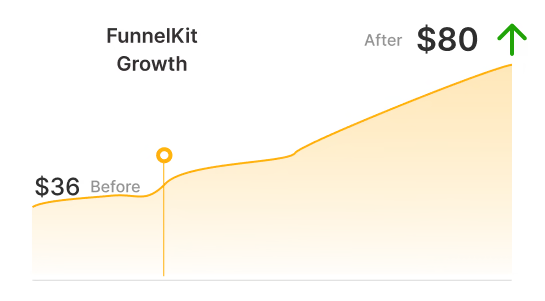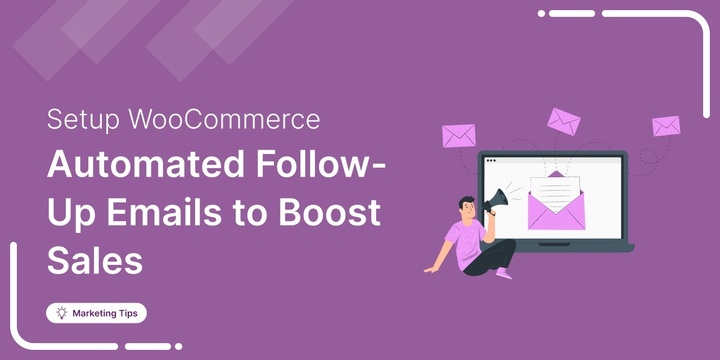
Want to turn one-time buyers into loyal customers?
Studies show that 50% of sales happen after the fifth follow-up email—yet most businesses give up way too soon.
That’s a lot of missed revenue!
With WooCommerce automated follow-up emails, you can keep your customers engaged, bring them back to buy again, and maximize every sale—without lifting a finger.
In this blog, we will share how you can set up automated follow ups for your WooCommerce customers right from your WordPress dashboard.
So let’s begin.
Table of Contents
- 1 What Are WooCommerce Follow-Up Emails and the Different Types?
- 2 Why Do E-Commerce Businesses Need to Have Follow Up Emails?
- 3 How to Set Up WooCommerce Automated Follow Up Emails for Free
- 4 6 Different Use Cases of Follow Up Emails with Example
- 5 How to Measure the Performance of Your Follow Up Emails?
- 6 7 Best Practices of WooCommerce Follow up Emails
- 7 Ready to Set Up WooCommerce Follow Up Emails?
What Are WooCommerce Follow-Up Emails and the Different Types?
WooCommerce follow-up emails are those you send to users after they interact with your website or make a purchase. The aim of such an email is to keep the engagement going.
Such emails assist you in maintaining your relationship with your customers. In addition, it also prevents the relationship cord from being cut. Some people confuse follow-up emails with transactional emails. But they are not the same! Transactional emails inform people of the whereabouts of their parcels. WooCommerce follow-up emails, on the other hand, can be pre-purchase and post-purchase.
With WooCommerce follow-up emails, you can send these different types of emails
- Abandoned cart reminders: Remind users about the items they left behind and encourage the to complete their purchases. You can include a small discount or free shipping offer to increase conversions.
- Post-purchase check-ins: Follow up with customers after they receive their order to ask about their shopping experience. This builds trust and gives you valuable feedback to improve your store.
- Product education emails: If your product requires setup or has specific usage instructions, send an email with helpful tips, guides, or video tutorials. This reduces customer confusion and increases satisfaction.
- Product recommendations: Suggest relevant or complementary items based on what the customer has already purchased. Personalized recommendations help increase repeat sales and improve the shopping experience.
- Loyalty discounts: Encourage repeat purchases by offering a specialdiscount or exclusive deal for returning customers. This helps build long-term relationships and boosts customer retention.
- Customer feedback requests: Send a short survey or ask for a product review after the purchase. This helps you understand customer satisfaction and improves credibility through social proof.
These emails are important for selling physical products and digital products.
Why Do E-Commerce Businesses Need to Have Follow Up Emails?
Boost sales with follow-ups
A customized follow-up email can encourage users to complete their order or buy again. Therefore, having a follow-up email strategy is critical for accelerating sales.
You can send users a follow-up email about cross-sale products to motivate them to make a second purchase. For example, if someone has bought a camera, you can ask if they need a ring light or tripods.
Sending customized emails based on the purchase history can help you increase your E-Commerce store's sales.
Retain more customers over time
Customer retention significantly impacts the ROI (return on investment). You don't get to lie when you don't communicate with a first-time customer.
Usually, users buy from multiple brands. As the website owner, you must communicate with them regularly so they don't forget you.
Engaging with customers regularly and sending follow-up emails to remind them about your amazing offers and deals can increase customer retention.
Strengthen relationships with buyers
One way to build a strong relationship with your customers is to show that you care. Care does not always have to be in the form of discounts.
You can also demonstrate concern for your customers by educating them about your product and suggesting related products they may find beneficial.
Engaging with your customer regularly will earn their trust. This will strengthen the foundation of your relationship.
Boost lifetime value with upsells & cross-sells
Follow-up emails are an excellent way to maximize customer lifetime value. By strategically offering upsells or complementary products, you can increase revenue per customer.
For instance, if a customer buys a laptop, sending a follow-up email recommending a laptop stand or extended warranty can lead to additional sales.
By leveraging upselling and cross-selling in follow-up emails, you ensure customers get more value while increasing your bottom line.
Hopefully, by now, you are convinced that follow-up emails can bring you newer heights of success.
Let's move to the next section to learn how to set up automated follow-up emails in WooCommerce.
How to Set Up WooCommerce Automated Follow Up Emails for Free
We are going to use a next-generation email automation solution - FunnelKit Automations. This plugin comes with various types of 15+ prebuilt automation recipes. Since these are ready to import, you can use them with minimal effort.
Best part? You can add unlimited contacts and send unlimited emails to your contacts.
This WooCommerce plugin offers 360-degree contacts overview, automation, integrated analytics & more. You can send unlimited emails to your users with a few clicks.
On top of that, you can also segment your audience based on their geographical as well as purchase history.
Sounds fascinating, right?
Let’s begin the process. Here we will show you how you can send automated cart abandonment recovery follow up emails from the WooCommerce dashboard.
🔔 Note: You can send other types of follow-up emails using FunnelKit Automation in a similar way.
Step 1: Install and activate FunnelKit Automations
The first step is to install and activate FunnelKit Automations as your WooCommerce follow up email plugin. You can install the free version from WordPress.org or WordPress dashboard.
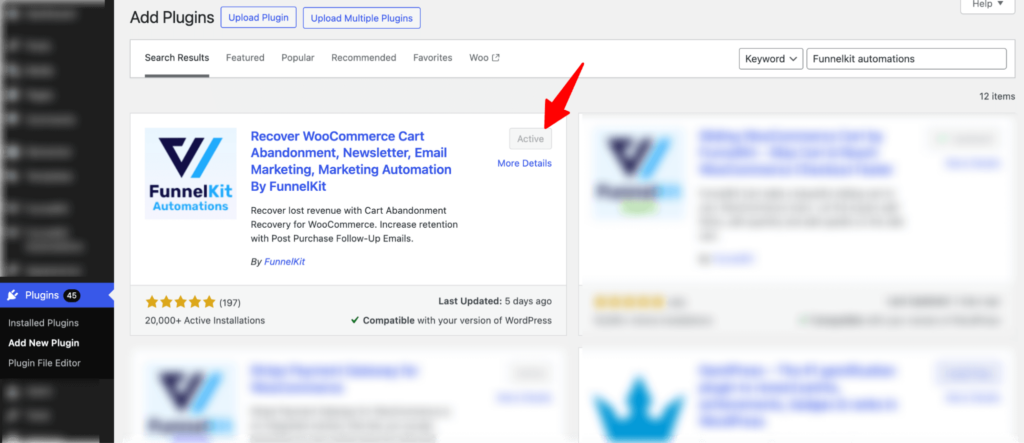
Step 2: Import abandoned cart reminder automation
Now, we are going to use an abandoned cart reminder prebuilt automation. This automation sends three sequential emails to encourage users to complete the checkout process for their abandoned carts.
Go to FunnelKit Automations ⇒ Automations and click Create Automation.
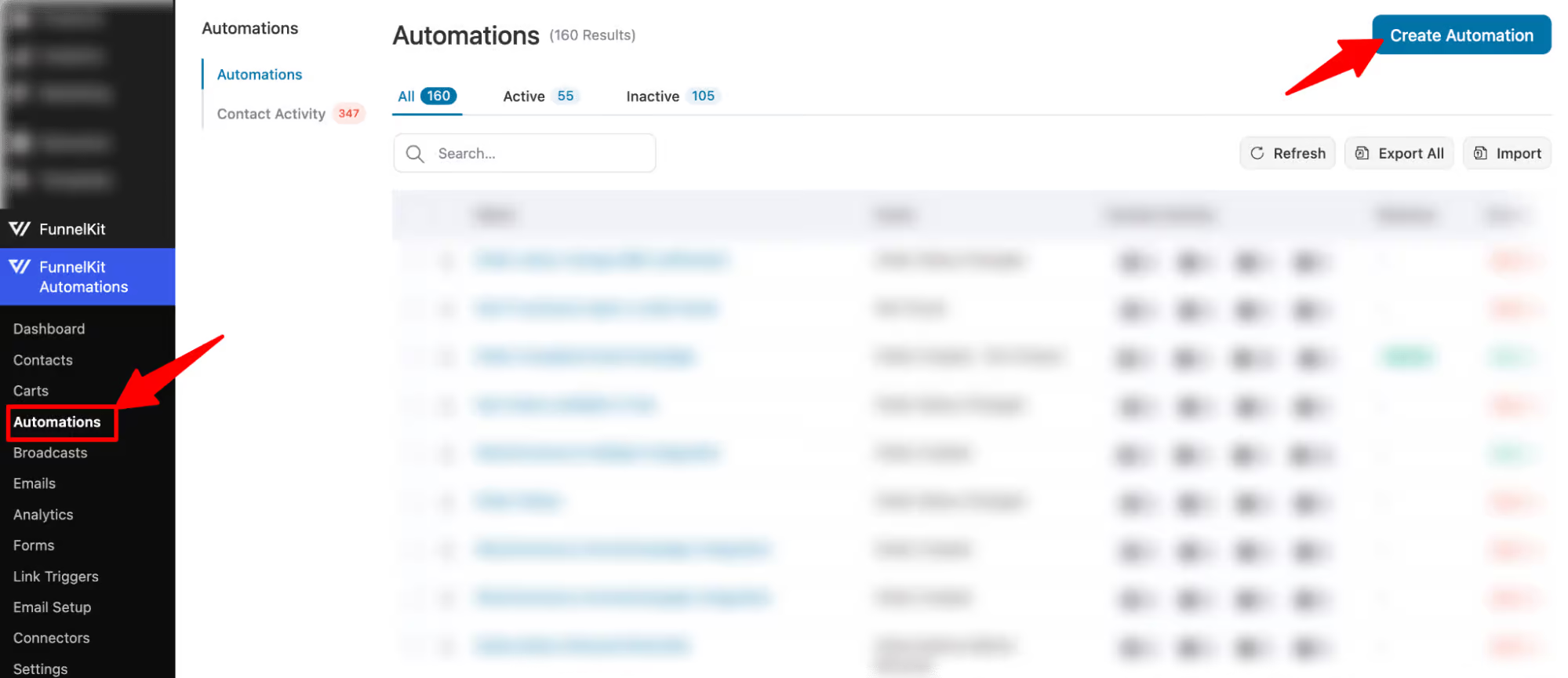
Now, click on Abandoned Cart Reminder from the list to send WooCommerce follow up emails free.
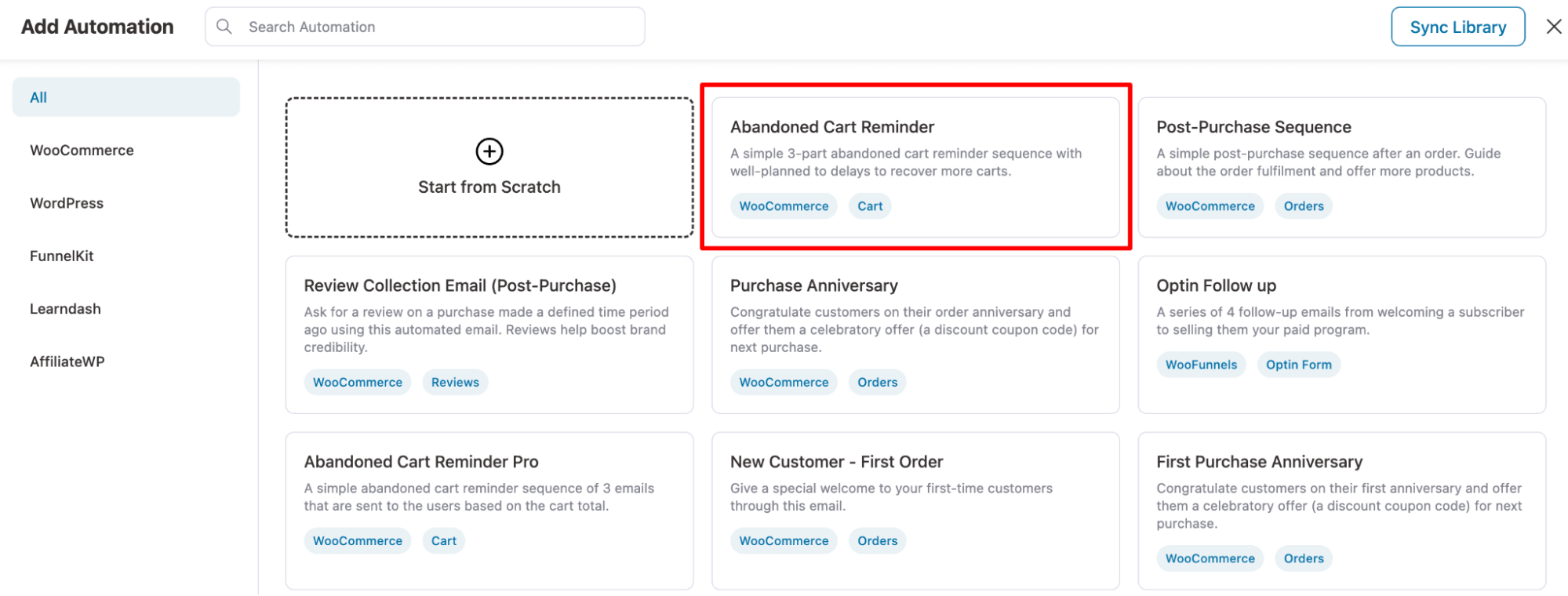
Now, to import the prebuilt recipe, click on Import. Then, provide a Name and click on Create.
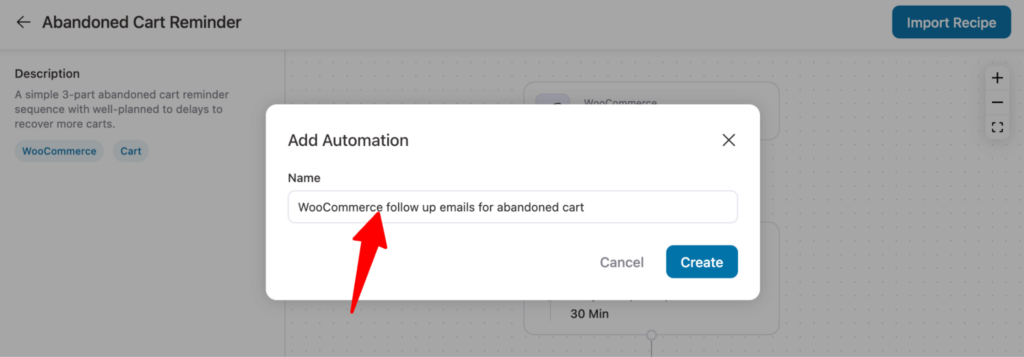
Step 3: Customize the WooCommerce follow up emails
Now, let’s go through each step of this automation so you can understand it better and customize it according to your needs.
The first step is to select the event that will trigger the follow up actions. In this case, of course, the event is cart abandonment. Click on the trigger to edit the settings related to the event.
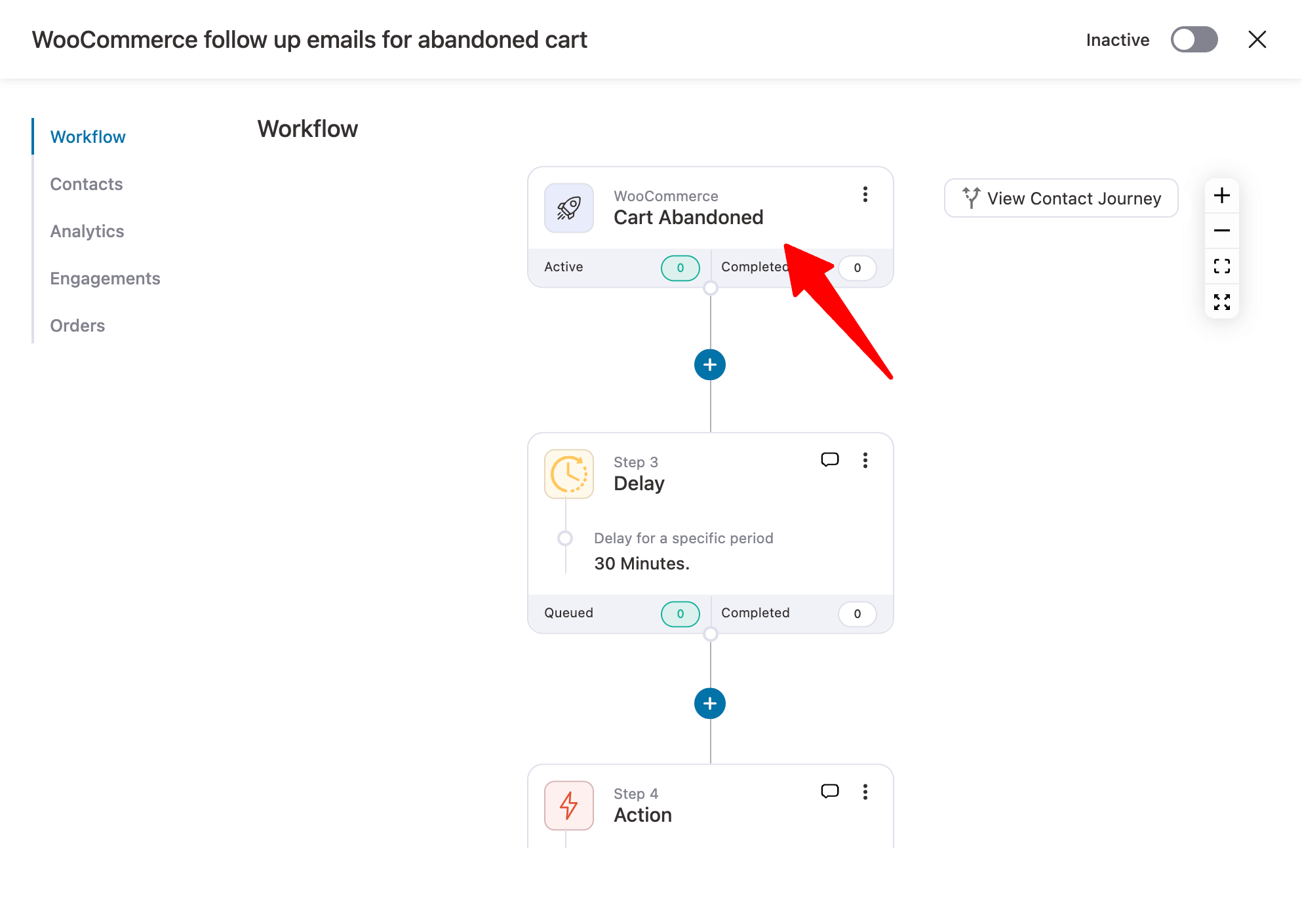
You can run this automation one or multiple times for each contact. Since a customer may leave their cart multiple times, it's wise to choose Multiple Times for the Run on Contact option.
For the same reason, it's advised to turn on the "Allow currently active contacts in this automation to re-enter again" option.
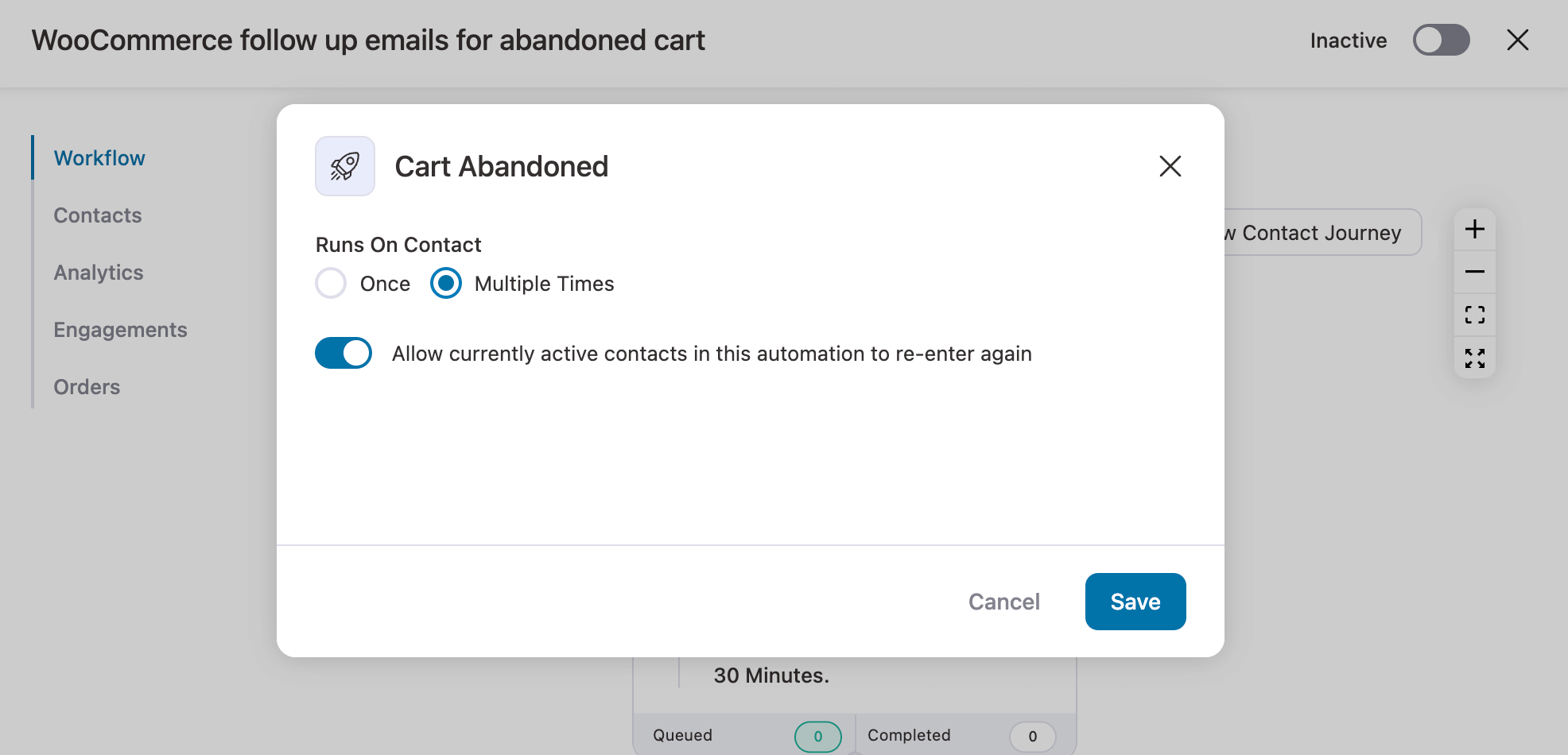
In the next step, the automation has a 30-minute delay, which means it will take 30 minutes to take the next step after someone abandons a cart. This is because if he/she comes back within 30 minutes to complete the order, then we can assume they never really abandoned it.
You can alter the first delay according to your follow-up strategy. You can create a delay of a specified number of hours, days, or weeks if you want.
🔔 Note: With FunnelKit Automations Pro, you can delay the first follow-up email until a specific date and time or custom field has been changed.

After the delay, the automation will send its first WooCommerce abandoned cart email.
FunnelKit Automations uses a merge tag to personalize the email. Merge tags help you add dynamic user information to the email.
For example, use the customer's first name in the subject line to personalize it.
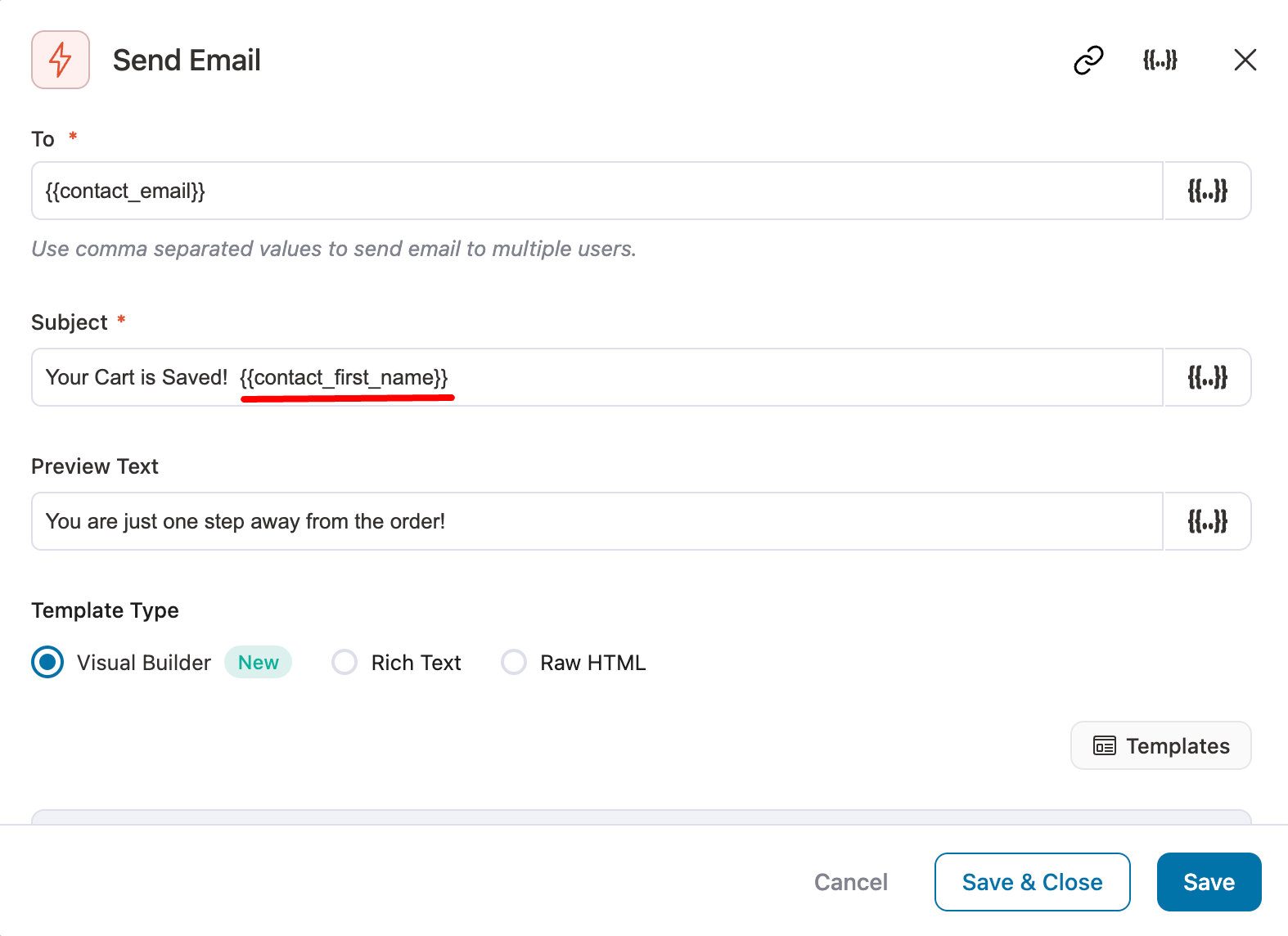
Here is a preview of the first automated follow-up email that comes with the prebuilt recipe
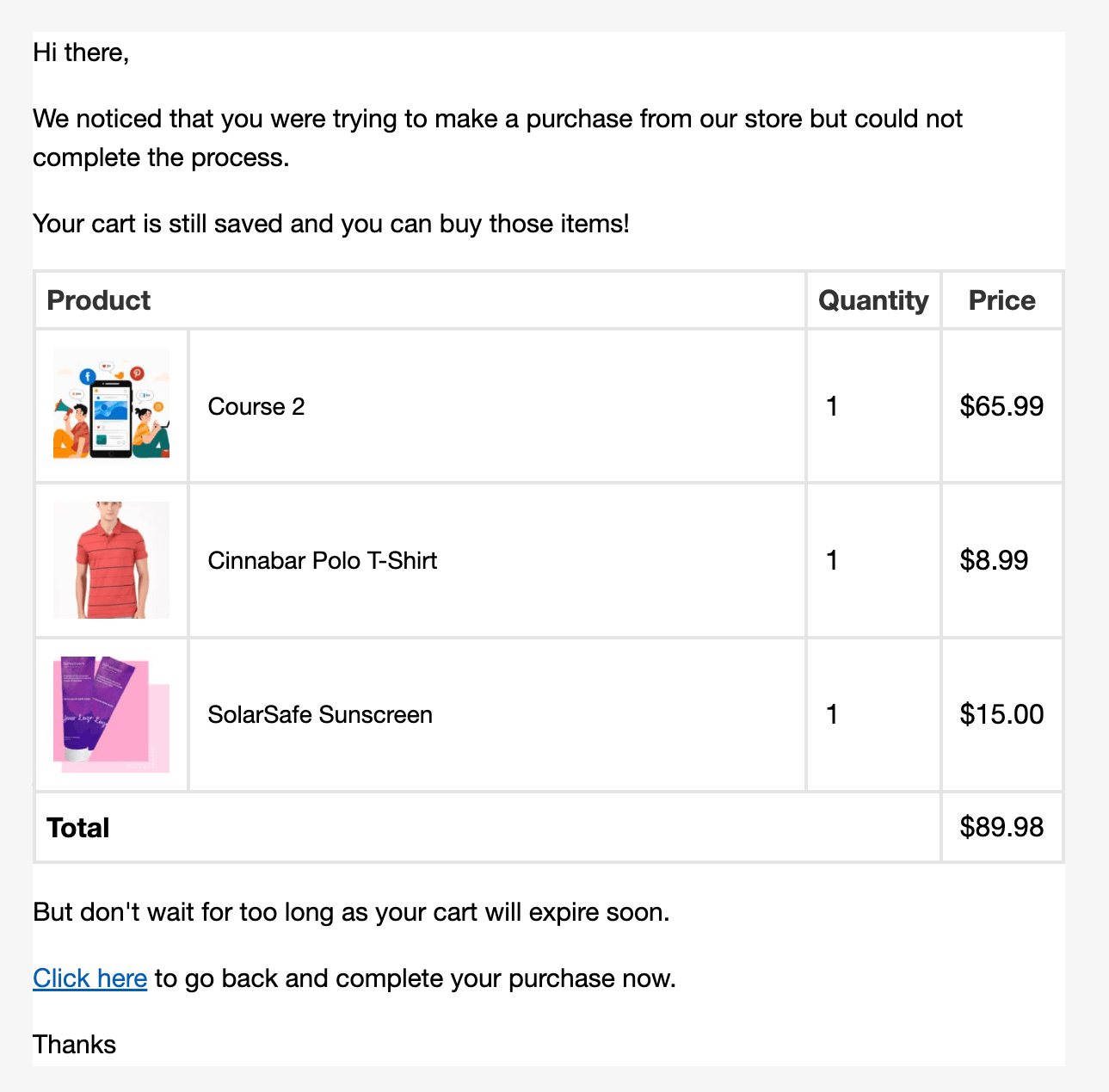
This template was built with Rich Text Editor. FunnelKit Automatons provides three options in total to design your WooCommerce automated emails. Visual Builder (New), Rich Text, and Raw HTML.
The Visual Builder (New) is the best option for creating visually appealing emails using drag-and-drop technology.
🔔 Note: This is a premium feature. You need to upgrade to FunnelKit Automations Pro to use the visual builder.
To do so, select Visual Builder (New) and click Edit.
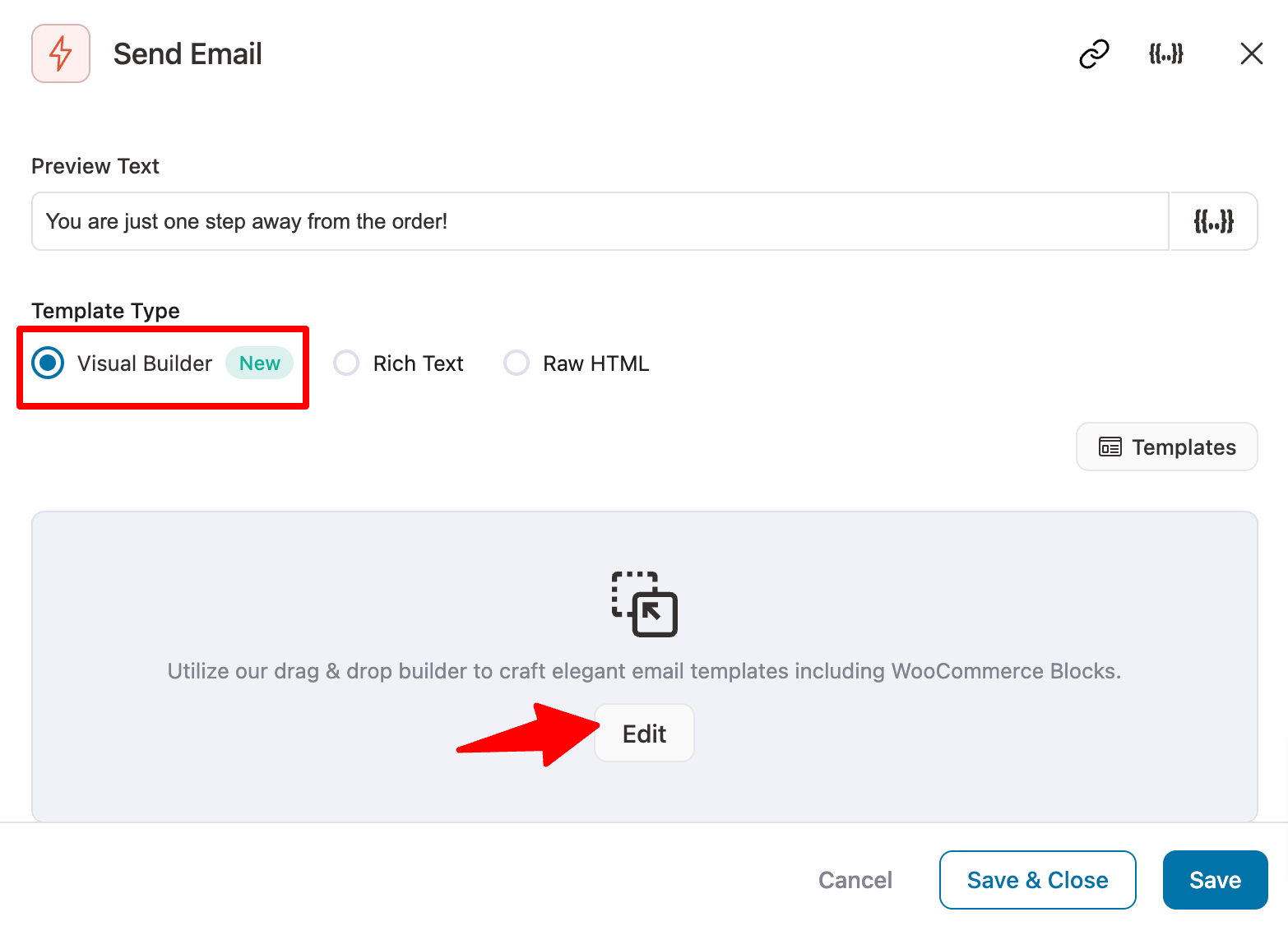
FunnelKit provides many pre-built email templates that you can import to use. Hover over the prebuilt template you like and click 'Preview.' FunnelKit Automations has an email template designed for abandoned carts, and we are going with that.
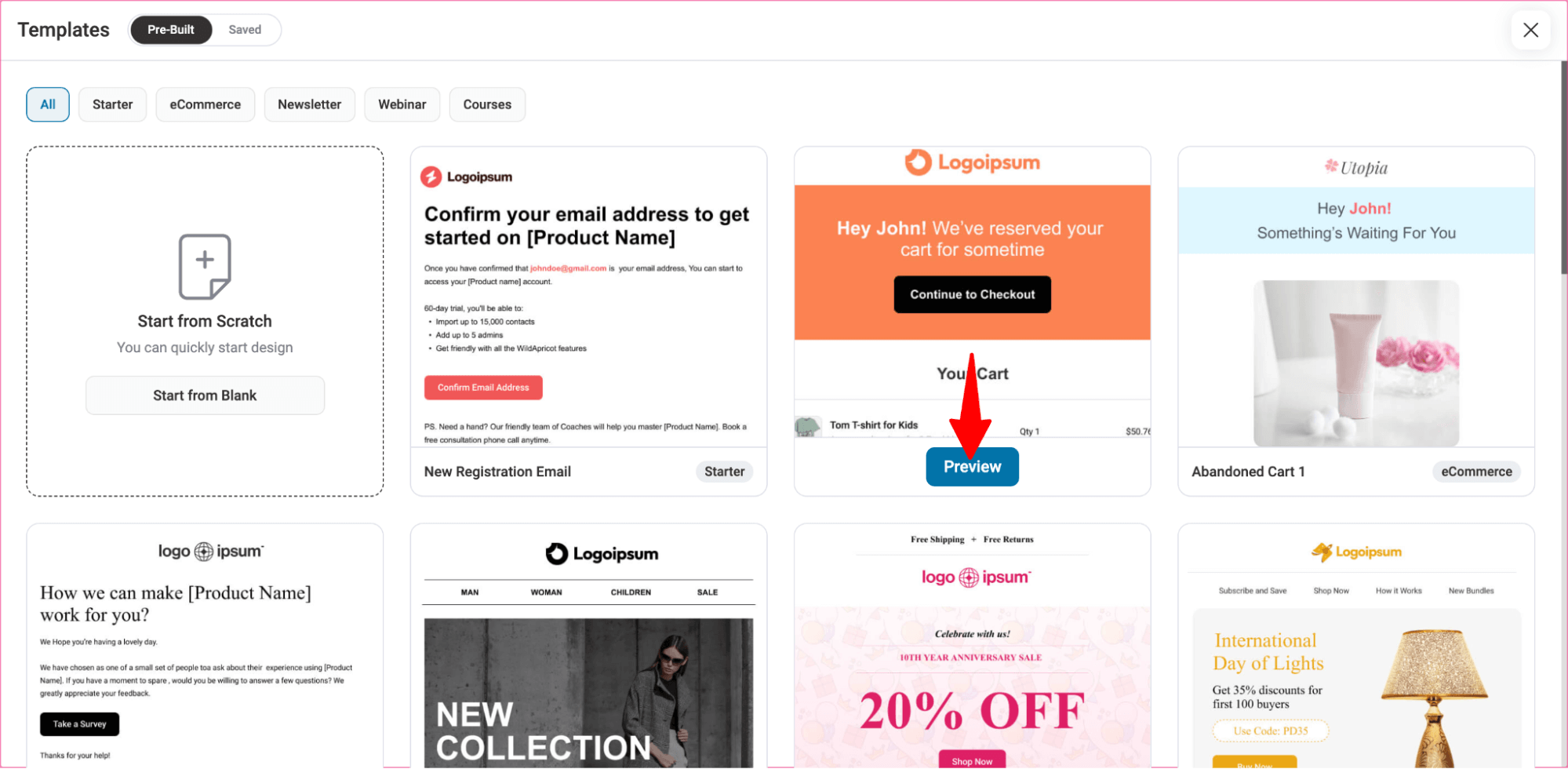
Then Click on “Import This Template” to import.
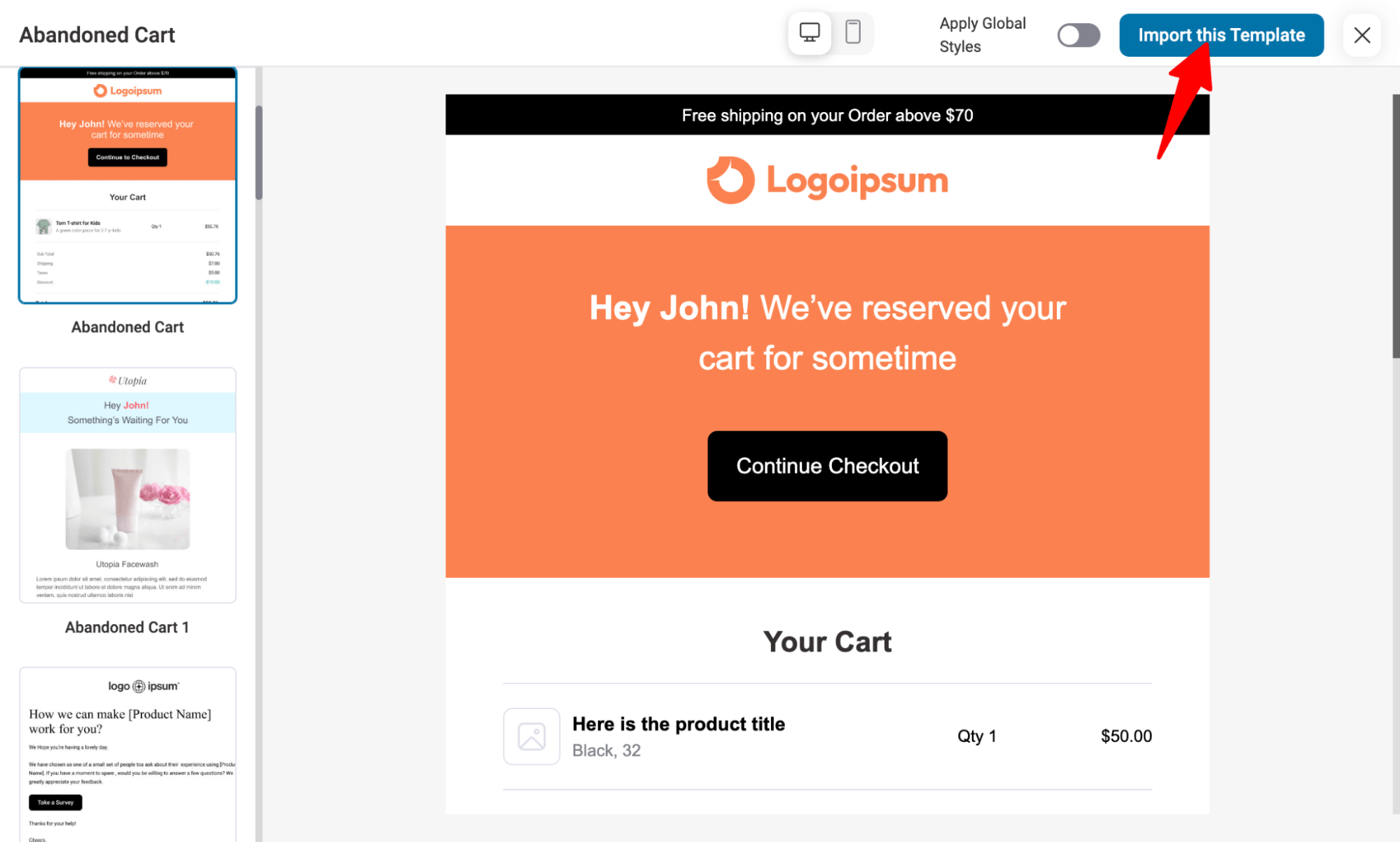
After importing, you can customize the email template’s content and design. You can remove or add any section. For more details, check our blog on “email customizer.”
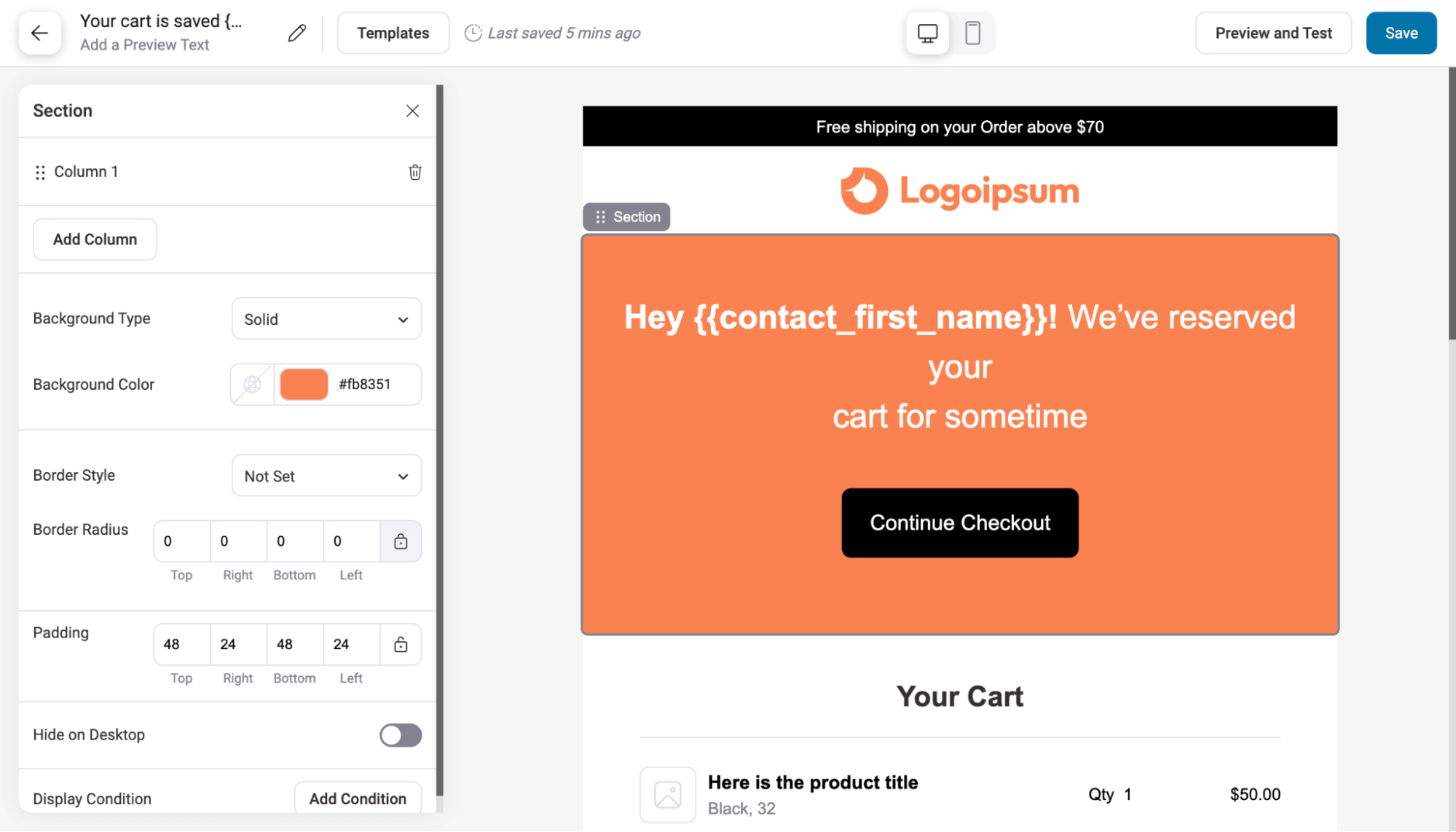
Here is a preview of the email built with the new visual builder :
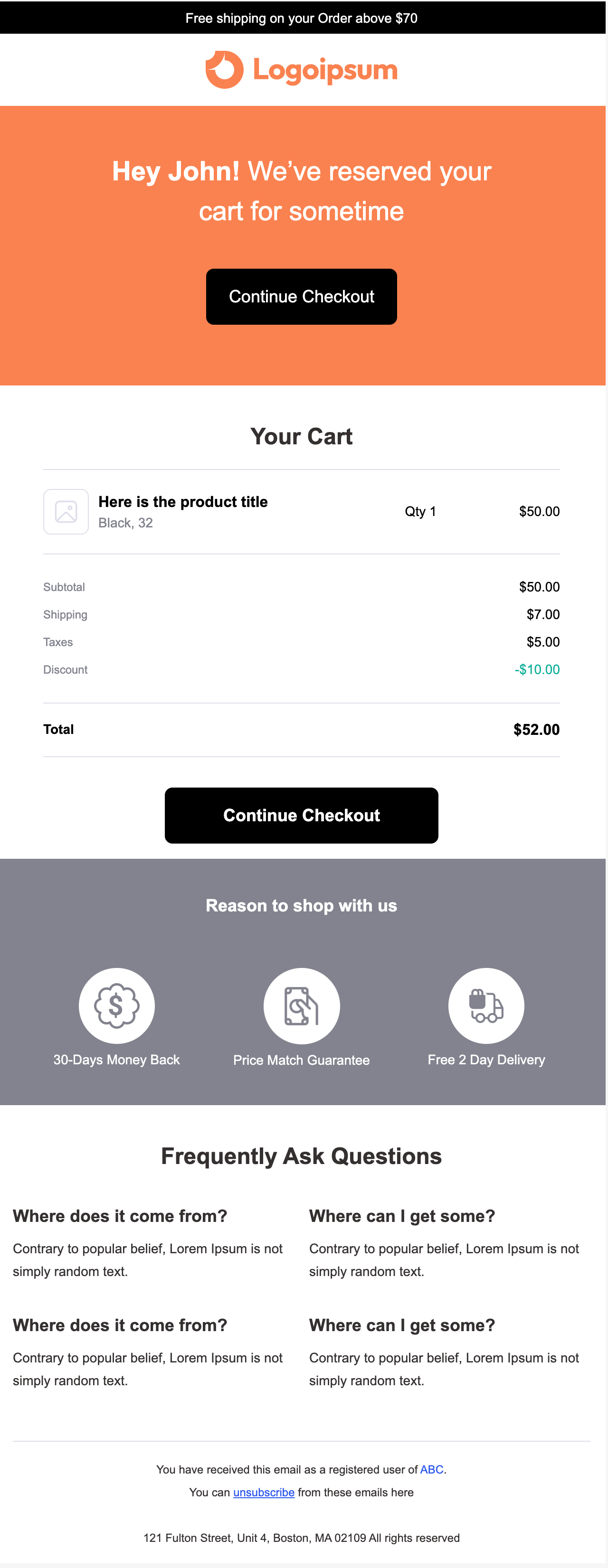
After the first email, this automation takes 12 and 24 hours delay consecutively and sends two more emails.
You can customize each step according to your strategy.
🔔 Note: You can also set up conditional-based workflows in your WooCommerce follow up email sequences. The conditions are only available in FunnelKit Pro. This conditional cart abandonment recipe is only available with FunnelKit Automations Pro.
Step 4: Activate the automation to send follow up emails
Once you are happy with each step of the email automation, click on the Active button in the top-right corner to activate the automation. This will start sending follow-up emails to WooCommerce users.
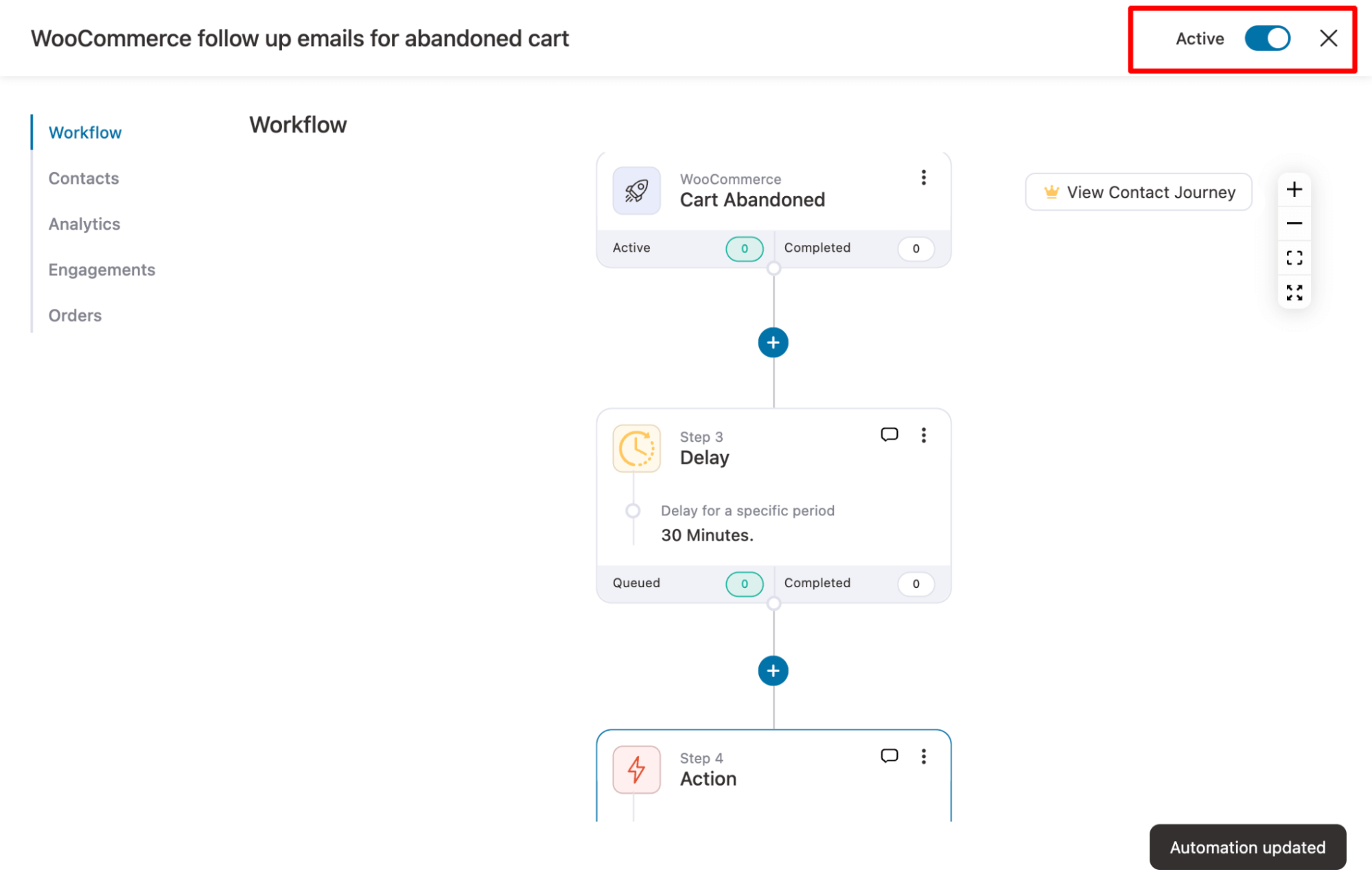
🔔 You can also read our blog What is an Email Drip Campaign and How to Create One in WordPress
6 Different Use Cases of Follow Up Emails with Example
Now that you know how easily you can send follow up emails, let's look at the types of automated emails you can utilize to grow your eCommerce business’s sales.
1. Shipment Check-In Email or Satisfaction Assessment Email
It is a follow up email that you send out to ask if the parcel was delivered as expected and if they're satisfied with the shopping experience.
Here's an example of a shipment check-in email from MOO:

We absolutely love this email because it comes from a character called 'Little Moo' which is a print robot, and it is very conversational as well.
This email works because you're training buyers to believe that there is a real person behind the store who cares about their satisfaction.
2. Cross-sell or Product Recommendation Email
A product recommendation email is an email in which you recommend items to your customers based on their recent purchases.
Since they've already bought from you, they know, like, and trust you. It's now time to leverage it.
Let's look at an example of a product recommendation email from a fashion store called Lowellita:
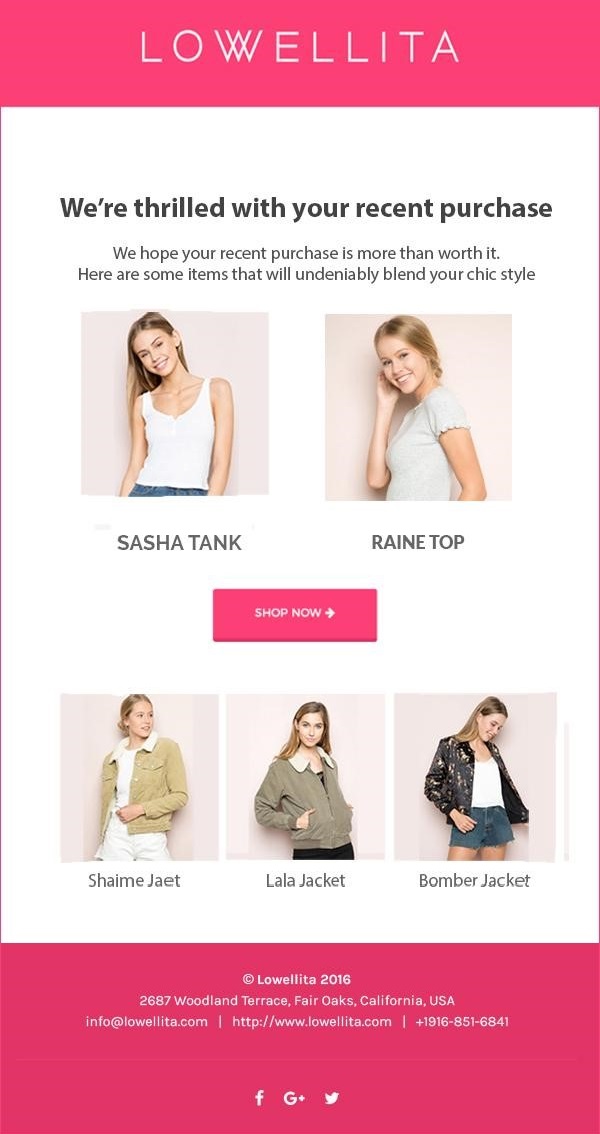
In this email, they're acknowledging that the customer has bought from them and that they're not just another prospect.
They also recommend items based on their recent purchase.
3. Purchase Anniversary Email
Purchase anniversary emails can be sent three months, six months, or one year after customers have made the purchase. You can choose the time when to send it out based on your strategy.
Here's a mind-boggling stat:
Take a look at an email from Zappos.
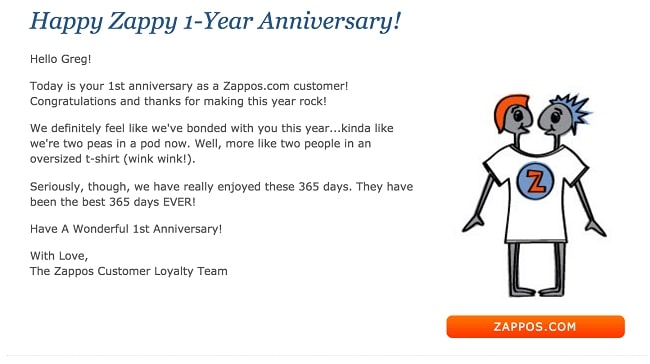
We love this email because it is brimming with personality.
In this email, they're simply wishing the customer and reminding them of the brand. Again, you can go a step further and offer an anniversary discount coupon code!
Related: Check out the ready to import first purchase anniversary and purchase anniversary recipes by FunnelKit Automaton.
4. Product Education Email
The educational emails guide users on how to get the most out of the products they've just bought.
As a store owner, you must send out WooCommerce follow up emails to help them at every step of the way.
It also leads to them having a memorable experience and makes them believe that you're not leaving them in the lurch.
Create a hands-on tutorial, a step-by-step plan to help them get started with your product.
Here's a wonderful example from a company called Framebridge that sells arts and frames:

They lead customers to an educational blog post where they explain how to hang their art pieces. Everything's laid out step by step.
Related: Check out the ready to import specific product education recipe by FunnelKit Automatons.
5. Customer Win-Back Campaign
If a customer hasn't bought from your store in 3 months or 6 months, you can send them a win-back campaign.
Most store owners don't acknowledge that the customer hasn't shopped in a while and continue to send blast emails.
You can set yourself apart by making an attempt to woo them back!
As per a stat published by MarketingLand.com, 45% of the customers who get a win back will open your future emails too.
And that's because a win-back email gets their attention and starts a conversation.
Here is an example of win-back email:

It's nice, witty, and to the point.
There's also a coupon code worth 15% off that they're offering to bring the customer back to the shop.
Related: Check out the ready to import customer winback campaign with coupon and customer winback without coupon recipes by FunnelKit Automatons.
6. Cart abandonment email
60% to 80% of customers abandon their shopping basket. Sending follow-up emails to these users is a tried and true method of getting them to complete the product.
Sending follow-up emails to these users has been shown to increase their likelihood of completing the product.
Cart abandonment emails are sent to users to remind them of their cart and to return to complete the order.
Here is an example of a cart abandonment email from the Tools Express team:
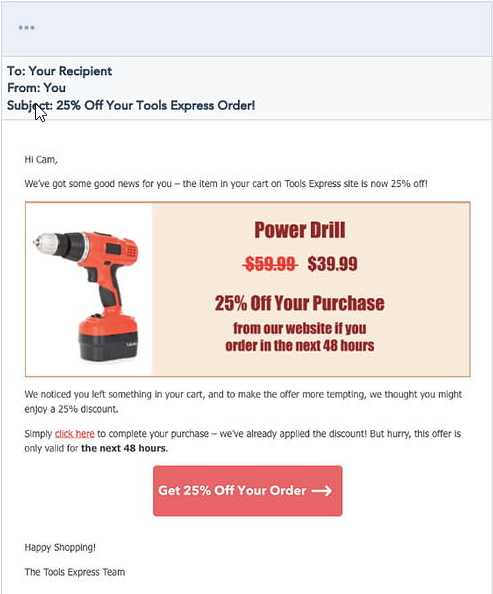
We like this email because it is personalized and includes a discount code with a time limit. The discount code serves as a strong incentive to complete the purchase process.
Related: Check out the ready to import Abandoned Cart Reminder, Abandoned Cart Reminder Pro and Abandoned Cart per product recipes by FunnelKit Automaton.
So, these were some of the pre purchase and post purchase follow up email use cases that you can use for your online business.
Now, let’s look at how you can measure the performance of your follow-up emails in the next section.
🔔 You can also read our blog on Triggered Emails: How to Generate 4x Times More Revenue
How to Measure the Performance of Your Follow Up Emails?
Just sending a bunch of follow up emails to your existing email addresses is not the end of action.
You need to measure the performance of follow-up emails. Based on the previous performance, you can take future action to improve the results your follow-up email will bring.
Here are some of the metrics you should consider while deciding whether a follow up email campaign is successful or not:
Track email engagement
You can track email engagement through key metrics like sent, open, click rate etc. These insights help you understand how users interact with your emails and optimize your strategy.
The click rate shows the percentage of people clicking links in your email, indicating engagement. A high open rate without clicks won’t drive sales, making it essential to monitor. With FunnelKit Automations, you can track email send, open and click rates.

Revenue/revenue per person
The primary purpose of follow-up emails is to increase sales and generate more revenue. That's why you must consider revenue earned from follow-up email campaigns as a metric to measure success.
Set a target revenue you want to achieve through a follow-up campaign. This will help you measure the success of your follow-up emails more effectively.

Unsubscribe rate
This matrix should be considered because a high unsubscribe rate indicates something is wrong with your follow-up emails.
You may be sending emails too frequently, at the incorrect time, or simply aren't communicating effectively with your audience.
When you know what's wrong, you can correct it so that your follow up email campaigns provide greater results.
The good news is that with FunnelKit Automations, you can also keep track of your email's unsubscribe rate.
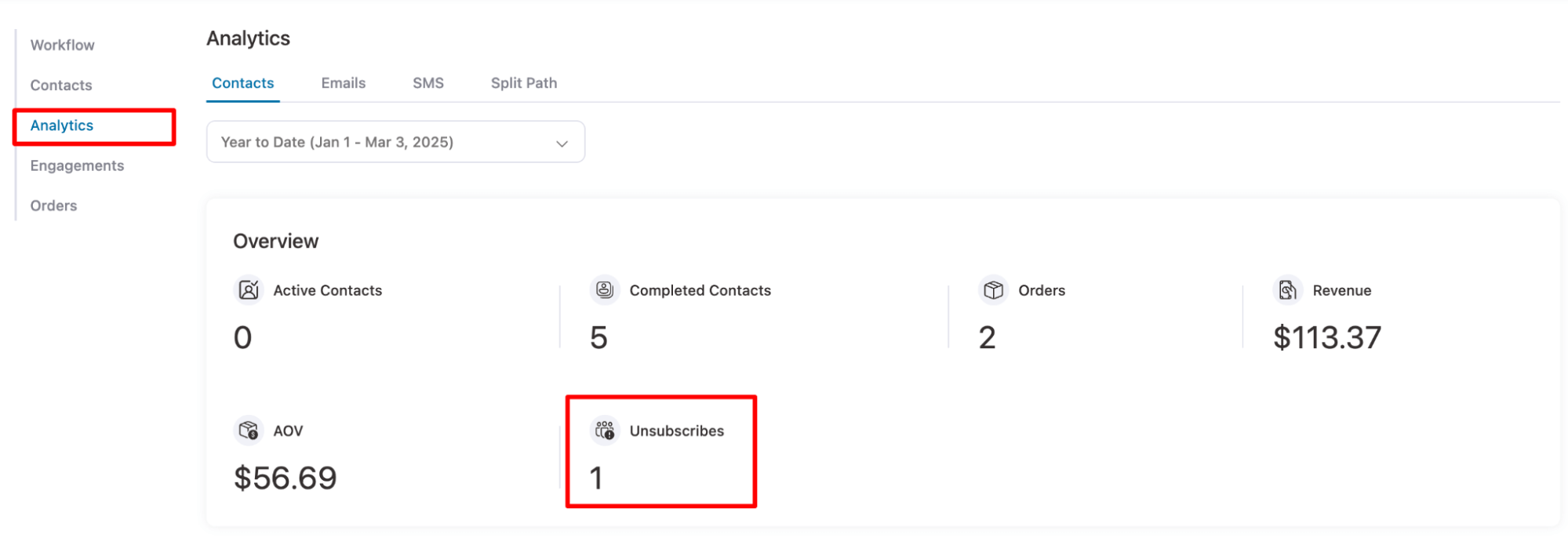
You can also read our blog How to Send a Broadcast Email from WordPress Dashboard?
7 Best Practices of WooCommerce Follow up Emails
Adopt a customer-focused strategy
Each follow up email you send should be customer-focused and add value to the customer's experience.
If your emails are designed to give value to your customers, they will engage with you more, increasing your chances of making more sales.
Segment your audience
Every consumer is unique, and you should treat them accordingly. Don't send generic follow up emails to every email address you have.
Instead, segment your audience based on their interaction with your website, purchase history, purchasing behavior, and so on to make follow up emails more effective.
🔔Note: With FunnelKit Automations, you can generate different audience lists based on how they interact with your WooCommerce site and utilize those audiences to send tailored follow up emails for a higher return.
Personalized and relevant information
In this competitive email marketing field, where customers are bombarded with many emails daily, sending personalized and relevant content in an email is a must-follow rule.
One technique for personalizing an email is to include customer information (like name, address, etc.) in the subject, preview, or body. Another option is to send follow-up emails based on their purchase history.
To summarize, try to personalize email in whatever manner you can.
Emails should be visually appealing.
An email with the correct information is not enough. The email should be aesthetically pleasing as well.
While adding an image to your email is a good idea, it doesn't necessarily have to be the case every time.
Even if your email is a text-based one, make sure it's formatted in the right way and easily readable for users.
Add a Call-to-Action button (CTA)
As mentioned, follow up email engages users with your email and converts.
To achieve this goal, you must add a clear CTA in your email body that tells users exactly what action to take for the next step. An email without a proper CTA is just a waste of time and effort for both users and store owners.
Show conditional content based on customer data
Make emails even more relevant by displaying content based on customer details like order status, customer details, purchase history, etc. This ensures users only see information that matters to them.
Create automation to ease your life.
Last but not least, automate your follow up emails. Manually sending follow-up emails is not difficult, but it is not the most practical choice.
A WooCommerce follow up automation will save you time and make the process more efficient, making your life easier.
You can use FunnelKit Automations to automate all kinds of follow up emails.
Ready to Set Up WooCommerce Follow Up Emails?
Now you are aware of different types of WooCommerce follow up emails and also the best practices.
Nurturing your audience with follow up emails has long-term benefits. Automating them will help you enjoy these benefits with minimal effort.
FunnelKit Automation is designed to help you create the best WooCommerce follow up emails. For that, it offers pre-built, ready-to-use recipes for almost all kinds of follow-up emails, such as Abandoned cart reminders, Specific product education, WordPress new user registration email, order confirmation email, WooCommerce first order discount, product review email, first purchase anniversary, discount for the next purchase, and many more.
Are you ready to start sending automated WooCommerce follow up emails?
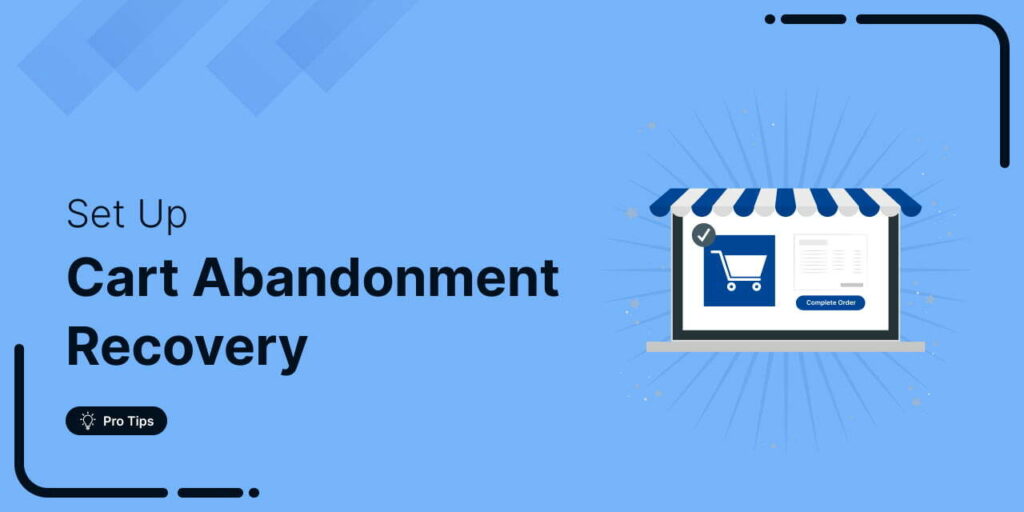
Editorial Team
November 27, 2025Every WooCommerce store faces it: shoppers add products to their cart, then vanish before completing checkout. In fact, studies show that nearly 70.22% (about 7 out of 10) of online...
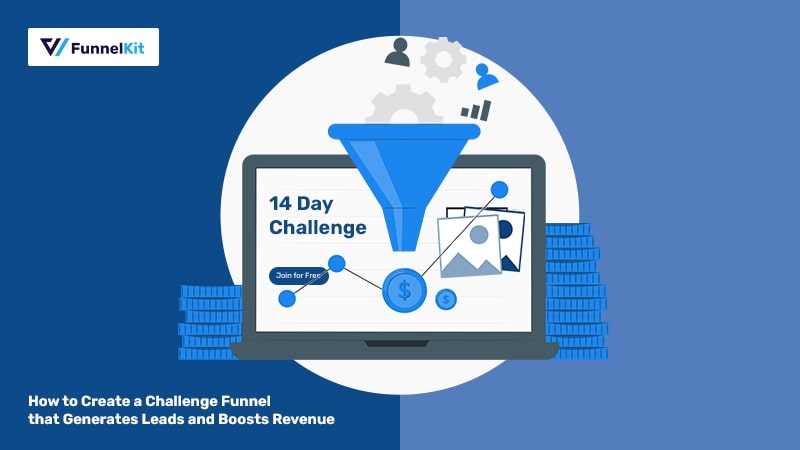
Editorial Team
November 19, 2025Among all the funnels a marketer can create, challenge funnels are fun and the fastest at converting visitors into buyers. Unlike a standard lead magnet that users download and forget,...

Editorial Team
November 13, 2025If you run a WordPress site, you know that your contacts are your most valuable asset. But managing them inside the default WordPress dashboard is nearly impossible. That’s where a...

